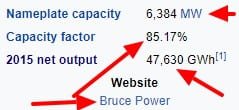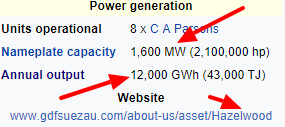Hillhater
100 TW
Does 6.5GWh per day sound any better than 0.25GWh average ?.....its the same output.billvon said:A 1GW plant will generate 1GW of POWER. A 1GW plant will generate 1GWhr of ENERGY an hour. A 1GW solar power plant in a good location in Australia will generate, on average, 6.5GWhr a day.Hillhater said:That will sadly only produce an average of 0.25Gwh of useable energy...jonescg said:.....There's about a GW worth of solar projects in the pipeline already......
..or less than half of one small old coal fired generator.
This is a good thing because power usage peaks during the day in most places.
This is a bad thing because people still need some power at night.
This is a good thing because it's very, very cheap.
This is a bad thing because utilities now have to manage unreliable generation - and that takes effort.
.........
But they are both guesses! In reality they are a "Best Result" figure, that doesnt allow for variations due to overcast , bad weather and those short winter days....which could easily reduce that "Best" number by 50-80 % .
Even poster Jonescg, who is a very tuned in electrical type guy, seems to have subconciously been indoctrinated by the headline "Installed GW Capacity" figures that the Solar industry are keen to promote.
It generally takes some searching and /or estimation to find real planned output capacity data.
"Very, very, cheap" .?.. is it ?
Keeping it close to reality, and using a real example that we have seen before, with documented data... the Topaz Solar plant..
https://en.m.wikipedia.org/wiki/Topaz_Solar_Farm
550 MW "installed" capacity, 1053 GWh annual output, $2.5 bn to build.
..How can that be "very cheap" per kWh ( i figure its $0.10/kWh just to cover a 20yr write down of capital)
They are sold as "cheap energy" because the source energy is free....but ask anyone who has installed their own roof top solar system,if it "free"
...and if you have to add on the cost of storage, then the numbers get real unpleasant !




